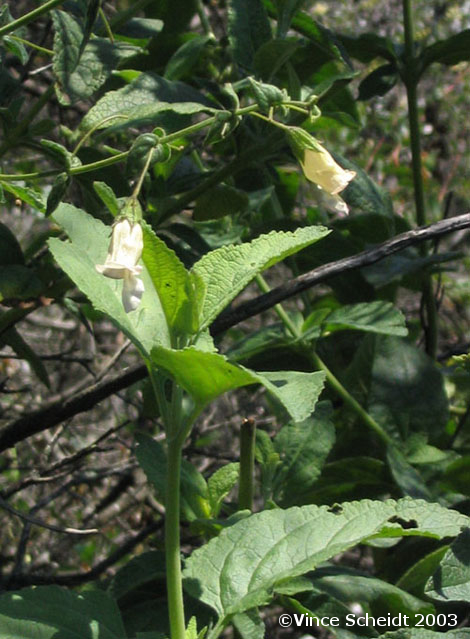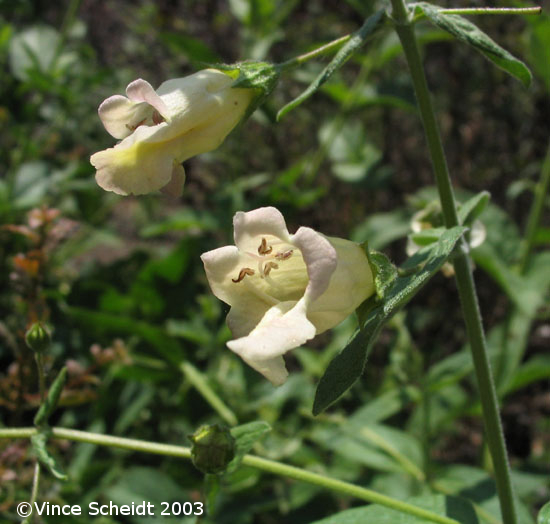
Heart-leaved Pitcher Sage
Lepechinia cardiophylla
Lepechinia cardiophylla

Heart-leaved Pitcher Sage
Lepechinia cardiophylla
Lepechinia cardiophylla
Goal: Maintain or enhance existing heart-leaved pitcher sage occurrences and establish new occurrences, as needed, to ensure multiple conserved occurrences with self sustaining populations to increase resilience to environmental and demographic stochasticity, maintain genetic diversity, and ensure persistence over the long term (>100 years) in chaparral and oak woodland vegetation communities.
Management units: 4, 5, 8
If extant occurrences of heart-leaved pitcher sage are discovered on Conserved Lands in 2017-2021, inspect the occurrences and repeat monitoring every 2 years. Use a regional monitoring protocol to record population abundance and collect habitat and threats covariate data to determine management needs.
| Action | Statement | Action status | Projects |
|---|---|---|---|
| IMP-1 | Based upon occurrence status and threats, determine management needs including whether routine management or more intensive management is warranted. | Available for implementation | Rare Plant Inspect and Manage Monitoring 2014-2026 |
| IMP-2 | Submit project metadata, monitoring datasets and management recommendations to the MSP Web Portal. | Available for implementation | Rare Plant Inspect and Manage Monitoring 2014-2026 |
| Criteria | Deadline year |
|---|---|
| If Extant Occurrences Found on Conserved Lands, Surveys Completed Every 2 Years with Management Recommendations | 2021 |
| Threat Name | Threat Code |
|---|---|
| Altered fire regime | ALTFIR |
| Human uses of the Preserves | HUMUSE |
| Invasive plants | INVPLA |
Management units: 4, 5, 8
If heart-leaved pitcher sage occurrences are found on Conserved Lands, conduct routine management actions identified through the IMG monitoring. Depending on the type and level of threat, management should be conducted as needed, not necessarily every year, and using BMPs with precautions to do no harm.
| Action | Statement | Action status | Projects |
|---|---|---|---|
| IMP-1 | Perform routine management activities such as protecting occurrences from disturbance through enforcement and controlling invasive non-native plant species to less than 20% absolute cover. | waiting for precedent action |
| Criteria | Deadline year |
|---|---|
| If Extant Occurrences Found on Conserved Lands, Routine Management Completed as Needed Based Upon Monitoring Recommendations | 2021 |
| Threat Name | Threat Code |
|---|---|
| Altered fire regime | ALTFIR |
| Human uses of the Preserves | HUMUSE |
| Invasive plants | INVPLA |
|
Rare Plant Inspect and Manage Monitoring 2014-2026
From 2014-2026, a Management and Monitoring Strategic Plan (MSP Roadmap) monitoring objective for 30 rare plant species is to inspect occurrences to determine management needs. The inspect and manage (IMG) objective is implemented to document the status of rare plant occurrences and assess habitats and threats to develop specific management recommendations. IMG monitoring is implemented by a combination of land managers and contracted biologists in coordination with the SDMMP. Available rare plant data is posted below. New annual updates are typically posted in March. Based upon an evaluation of these data, a 2014-2026 monitoring schedule has been developed for the 30 rare plant species (attached below). Coordinating data collection across the region allows analyses of species and population trends over time and provides a better understanding of the association between habitat and threat covariates and population dynamics.
|
|
Valley Fire Rare Plant Discovery Surveys
A project between the SDMMP and US Forest Service to establish and prioritize survey areas on Conserved Lands within the perimeter of the 2020 Valley Fire to document whether historic occurrences are extant and to discover new occurrences for 18 rare plant species. In 2022, AECOM and Conservation Biology Institute botanists surveyed areas for 18 target rare plant species and mapped the spatial extent of each new occurrence, counted or estimated the occurrence population size, and collected voucher specimens. They also photographed each new occurrence from a georeferenced location that captured a representative view of the occurrence. Botanists created a species list for the areas surveyed within the Valley Fire footprint. These areas included locations where rare plants were detected and mapped and negative data point areas where rare plants were not detected. In 2023, botanists shall again conduct surveys on suitable habitat on USFS lands burned in the 2020 Valley Fire. Results from these surveys should lead to a greater understanding of post-fire rare plant composition. In 2023, botanists may see species that did not emerge in the first year of surveys, and species found in the first year of surveys may have expanded their range. The 18 rare plant species included in the surveys are: San Diego thornmint (Acanthomintha ilicifolia), Marvin's allium (Allium marvinii), Western spleenwort (Asplenium vespertinum), Deane's milkvetch (Astragalus deanei), Encinitas baccharis (Baccharis vanessae), San Diego goldenstar (Bloomeria clevelandii), Orcutt's brodiaea (Brodiaea orcuttii), Lakeside ceanothus (Ceanothus cyaneus), San Miguel savory (Clinopodium chandleri), Variegated dudleya (Dudleya variegata), Mission Canyon bluecup (Githopsis diffusa filicaulis), Ramona horkelia (Horkelia truncata), Heart-leaved pitcher sage (Lepechinia cardiophylla), Felt-leaved pitcher sage (Monardella hypoleuca lanata), Chaparral nolina (Nolina cismontana), Gander's ragwort (Packera ganderi), Moreno currant (Ribes canthariforme), and Parry's tetracoccus (Tetracoccus dioicus).
|
| File name | Lead Author | Year | Type |
|---|---|---|---|
| County of San Diego MSCP Monitoring Summary Report January 1998 - June 2007 | County of San Diego | 2007 | report |
| Management Strategic Plan (MSP) 2015 Monitoring Protocol for Rare Plant Occurrences on Conserved Lands in Western San Diego County | San Diego Management and Monitoring Program | 2015 | report |
| San Diego Rare Plant Monitoring Plan: Fiscal Year 2011 | Greer, Keith; McEachern, Kathryn; Tracey, Jeff | 2011 | report |
Restricted to Santa Ana Mountains in Orange and Riverside counties, Iron Mountain in San Diego County and Baja California [1,2,3,4].
Within the MSPA two small conserved occurrences in MU8 (<500 individuals) in relatively close proximity (Wilderness Gardens and Mount Olympus Preserves; [5]).
None.
Occurs in closed-cone coniferous forest, chaparral and cismontane woodland 550-1,370 m [1,3,4]. Associated with southern oak woodland forest with scattered Coulter pine and big cone spruce chaparral-oak woodland, and chamise chaparral. Soil conditions include Friant rocky fine sandy loams (Iron Mountain, San Diego County), Exchequer soils (Orange County), volcanic soils (Baja California; [3]).
In family Lamiaceae [6]. One of five species of genus Lepechinia in California [7]; the five share traits indicating they derived from repeated instances of range expansion and contact among species with hybridization followed by range contraction and isolation of populations with subsequent differentiation resulting from drift and natural selection [1,7]. No species-specific studies regarding population genetics located. Members of the genus have a diploid chromosome (2n) number of 32 [6].
Flowers funnel-shaped, white to lavender-tinged in color [2]. Calyx becomes scarlet purple and enlarges in fruit. Glaborous round to oblong fruit, one-seeded, 2-4 mm in diameter
Perennial shrub; blooms April-July [4].
No information.
Threatened by development; potentially threatened by road maintenance, powerline installation, and fuel break maintenance [4].
Reported to be a fire follower [8].
[1] . Epling, C. 1948. A Synopsis of the Tribe Lepechinieae (Labiatae). Brittonia 6(3): 352-364.
[2] . Munz, P.A. 1974. A Flora of Southern California. University of California Press, Berkeley, California.
[3] . Reiser, C. H. 1994. Rare Plants of San Diego County. Unpublished. Aquafir Press, Imperial Beach, California. Available online: http://sandiego.sierraclub.org/rareplants/